#advice for writing plot
Explore tagged Tumblr posts
Text
sometimes the best writing advice is "just let it be bad." revolutionary. terrifying. but it works.
#writing#writeblr#writer problems#writing humor#writers on tumblr#writing memes#writing community#writing struggles#writer life#creative writing#writer things#writing motivation#ao3 writer#writer memes#writing is hard#on writing#writerblr#writers block#writing funny#writer thoughts#fiction writing#writer struggles#writing tips#writing advice#writer woes#writing woes#writer quotes#writing inspiration#plot problems#writer chaos
38K notes
·
View notes
Text

me when the plot won't plot like it should
#just plot would you?#writeblr#novel writing#writing#my writing#fantasy#novel#books#wip#writers block#writers#writing community#writing prompt#writing inspiration#writing tips#writing advice#creative writing#on writing#writer stuff#writer problems#writer things#writer life#writer thoughts#writers on tumblr#writerscommunity#writing stuff#thewordsarestuckinmyhead
11K notes
·
View notes
Text
Tips from a Beta Reading Writer
This one's for the scenes with multiple characters, and you're not sure how to keep everyone involved.
Writing group scenes is chaos. Someone’s talking, someone’s interrupting, someone’s zoning out thinking about breadsticks. And if you’re not careful, half your cast fades into the background like NPCs in a video game. I used to struggle with this so much—my characters would just exist in the scene without actually affecting it. But here’s what I've learned and have started implementing:
✨ Give everyone a job in the scene ✨
Not their literal job—like, not everyone needs to be solving a crime or casting spells. I mean: Why are they in this moment? What’s their role in the conversation?
My favourite examples are:
The Driver: Moves the convo forward. They have an agenda, they’re pushing the action.
The Instigator: Pokes the bear. Asks the messy questions. Stirring the pot like a chef on a mission.
The Voice of Reason: "Guys, maybe we don’t commit arson today?"
The Distracted One: Completely in their own world. Tuning out, doodling on a napkin, thinking about their ex.
The Observer: Not saying much, but noticing everything. (Quiet characters still have presence!)
The Wild Card: Who knows what they’ll do? Certainly not them. Probably about to make things worse.
If a character has no function, they’ll disappear. Give them something—even if it’s just a side comment, a reaction, or stealing fries off someone’s plate. Keep them interesting, and your readers will stay interested too.
#Tips from the cranberry queen#writing#writeblr#writer problems#writing humor#writers on tumblr#writing memes#writing community#writing struggles#writer life#creative writing#writer things#writing motivation#ao3 writer#writer memes#writing is hard#on writing#writerblr#writers block#writing funny#writer thoughts#fiction writing#writer struggles#writing tips#writing advice#writer woes#writing woes#writer quotes#writing inspiration#plot problems
8K notes
·
View notes
Text
Writing Tips Master Post
Edit: Some posts may be deleted
Character writing/development:
Character Arcs
Making Character Profiles
Character Development
Comic Relief Arc
Internal Conflict
Character Voices
Creating Distinct Characters
Creating Likeable Characters
Writing Strong Female Characters
Writing POC Characters
Building Tension
Writing Grumpy x Sunshine Tropes
Writing Sexuality & Gender
Writing Manipulative Characters
Writing Mature Young Characters
Plot devices/development:
Intrigue in Storytelling
Enemies to Lovers
Alternatives to Killing Characters
Worldbuilding
Misdirection
Things to Consider Before Killing Characters
Foreshadowing
Narrative (+ how to write):
Emphasising the Stakes
Avoid Info-Dumping
Writing Without Dialogue
1st vs. 2nd vs. 3rd Perspective
Fight Scenes (+ More)
Transitions
Pacing
Writing Prologues
Dialogue Tips
Writing War
Writing Cheating
Writing Miscommunication
Writing Unrequited Love
Writing a Slow Burn Btwn Introverts
Writing Smut
Writing Admiration Without Attraction
Writing Dual POVs
Writing Unreliable Narrators
Worldbuilding:
Worldbuilding: Questions to Consider
Creating Laws/Rules in Fantasy Worlds
Book writing:
Connected vs. Stand-Alone Series
A & B Stories
Writer resources:
Writing YouTube Channels, Podcasts, & Blogs
Online Writing Resources
Outlining/Writing/Editing Software
Translation Software for Writing
Writer help:
Losing Passion/Burnout
Overcoming Writer's Block
Fantasy terms:
How To Name Fantasy Races (Step-by-Step)
Naming Elemental Races
Naming Fire-Related Races
How To Name Fantasy Places
Ask games:
Character Ask Game #1
Character Ask Game #2
Character Ask Game #3
Miscellaneous:
Writing Tips
Writing Fantasy
Miscommunication Prompts
Variety in Sentence Structure (avoiding repetition)
#masterlist#masterpost#writeblr#writing#writing tips#writing advice#writing help#writing resources#author resources#writer resources#creative writing#character writing#character development#plot development#narrative#book writing#writers block#writer stuff#writer things#fantasy writing#writer ask game#deception-united
28K notes
·
View notes
Text
THANK YOU SO MUCH I've been needing something like this to put plot stuff clearly into something tangible from the messy bits of plot knowledge all over my brain
3hks' Guide to Plot (2024)
Alright guys... Here's a big one! These are MY personal thoughts on how to create and write plot. As time continues, I'm positive that some of these things will change, which is why I included "(2024)" in the title! Let's start with some of the basics and definitions, shall we? Hint: you probably want to see the last tip!
~PLOT STRUCTURE~
For 99.9% of novels, they follow a similar--if not the same plot structure--so let's take a look at them chronologically!
>>> Exposition: The beginning of the story, the starting characters, settings, relationships, and ideas are established. This is meant to give the reader a basic sense of the story.
>>> Inciting Incident (initial conflict): This is what sparks the conflict. The characters themselves may not realize it, but this event ultimately changes the whole course of the plot! (This may not always be before the rising action.)
>>> Rising Action: The GOOD stuff starts here! More introductions, more development, more action! Tension builds as the story continues.
>>> Climax: The climax is NOT equivalent to the conflict. The climax is the most exciting or tensest part of the story. The protagonist often is forced into making a difficult decision, whether it be self-inflicted or by another character's hand.
>>> Falling Action: The climax has ended, and things are coming to an end! The falling action is always shorter than the rising action, because there isn't much to introduce, and the characters are simply rolling through the consequences (good or bad) of their previous actions.
>>> Resolution: This is the end of the story. Many people will tell you to tie all the knots together during this part, but it's ultimately up to you! However, there should be some sort of ending to provide closure, at the very least. The conflict should also be resolved (hence the name).
Let's look at the diagram itself! (I'm using Freytag's pyramid because it's well-known. Thank you Writer's Hive for the image!)
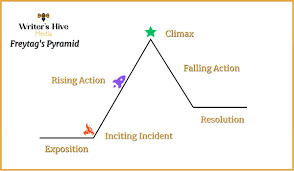
~CONFLICT~
Alright, let's talk about the types of conflict real quick!
Character v.s Character: This is your typical conflict, where there are two opposing characters struggling against each other.
Character v.s Self: This is a less common conflict that takes place within the character's mind. (Examples: Self-doubt, decision making, moral dilemma, etc.)
Character v.s Society: This is a conflict between a character (or even a small group of characters) struggling against a larger, typically oppressive society as a whole.
Character v.s. Nature: Just like in the name, this is a character against a force of nature: a tornado, storm, flood, etc.
Character v.s Supernatural: Simply put, this is just a character struggling against a supernatural force.
While knowing and being able to identify the different conflicts doesn't necessarily help you write, it's important to understand what your character is battling against in order to build the conflict.
~BUILDING THE ARCS~
If you watch a lot of shows or movies, you're probably familiar with the term "arc," which is just another way to say plot or subplot, depending on your story.
When writing plot, you want to have a MAIN or LEADING ARC. This is your character's goal that's usually established at the exposition. However, there is usually more to add so your storyline isn't too one-dimensional. These are more arcs or subplots that simply branch out. In a way, it's meant to slow the plot down and add more content while still advancing the story.
So yeah, subplots are able to assist in slowing down the story but they need to help advance the main arc.
This can be done by simply connecting the two--making sure that both of them are at least relevant to one another.
Here's an example! Let's look at HunterxHunter (Yoshihiro Togashi)
The main character, Gon, has a goal to locate his father. This is what HunterxHunter is mainly about. The leading arc, main plot, etc.
It's incredibly simple and straightforward, but it's not that easy.
Along the way, you see different problems arise, creating more subtle and smaller arcs. For instance, there's the Yorknew arc, the Greed Island arc, and the Chimera Ant arc.
The focus of those arcs aren't necessarily for Gon to find his dad. As a matter of fact, his objective is kind of an afterthought in the presence of these subplots. Still, they are connected to Gon's objective and push the story!
See how modest the main plot is? It does not have to be the world's most complex storyline.
Your protagonist's goal is the leading arc, and things just get in the way of it.
Keep this in mind and it may actually help you design your plot events!
~KEY POINTS~
Character introductions: By the end of the rising action, you want most of your characters to have been introduced. This may vary for some certain scenarios, but logically, most characters are going to be involved in the climax, so they must be introduced beforehand.
Environment: Your character will typically start out with a set view of their society, world, and people. Through your developing plot, there should be some changes in their view. What they believe is true could prove to be false.
Triumphs and losses: Sometimes, your character needs to win, and sometimes, they need to lose. This adds a sense of naturalness (not everyone gets what they want) and aids your character development. There are times when a loss is actually the foundation of the exposition! (Wink-wink, nudge-nudge)
~WHERE TO PLACE "THAT SCENE"~
Here's a pretty big one! As writers, we often have just "that scene" pictured out in our minds--it's absolute perfection and a REAL piece of art.
But where are we going to insert it?
If it's not too important, there are three places I suggest! 1. The exposition, 2. the rising action, 3. the falling action.
If your moment is able to introduce a relationship, character, or setting, the exposition is the way to go. If it can build on the three things I listed AND may have a part in the conflict and/or climax, then rising action it is! If it's somewhere in between and somewhere else, then try falling action!
And it can even be the inciting incident if begins the conflict!
Resolution is also a possibility, but because it's near the end, your scene may have less impact than you want. However, if you're still into that idea, then I suggest placing it at the very end! (You'll just need a lot of patience to get through your whole story just for that part, though lol.)
The most important part is to understand what the moment can contribute to the plot, because then you'll have a much better idea of whether you should place it closer to the climax or further away!
Did this help? Let me know!
Happy writing~
3hks <3
#writing#writeblr#writerscommunity#writing tips#creative writing#writing inspo#writing advice#writing plot#how to write plot#tips for writing plot#advice for writing plot#tips on how to write plot#advice on how to write plot
174 notes
·
View notes
Text
<div style="white-space:pre-wrap">
🧠 FREE WRITING LESSON — THE MOST POWERFUL CHARACTER DEPTH TRICK YOU’LL EVER READ.
Let’s say your character sucks.
She’s flat. Predictable. “Strong” in all the wrong ways. Let’s call her Nicolle. Or Carol. Or whatever name Hollywood gave her.
She’s a superhero. She’s got powers. She’s got sarcasm. She takes no shit. She leads the squad. She’s admired by everyone — and loved by no one.
You’ve seen this character before. Now watch what happens when you give her one secret she doesn’t brag about.
Nicolle has two sons.
She’s raising them alone — to become men like her late father: A man who sacrificed everything to raise her after her mother disappeared, broke, or gave up.
The world sees Nicolle as the apex of visual empowerment. But the world doesn’t see:
The arguments with her boys’ father — about what being a real dad means.
The prayers whispered in the dark over a fevered forehead.
The way she ghosted the only man she maybe wanted, not because she’s flaky — but because she doesn’t know if wanting love makes her a bad mother.
The nights she tucks her boys in, then collapses into her bed, staring at the ceiling, heart full of ache, because she gave the world her strength but kept no one to hold hers.
They don’t see the days her sons cry after watching her get slammed through buildings on TV.
Held by the throat. Left for dead. Motionless for seconds too long. Until she rises — because she has to.
They don’t see the breakdowns. They don’t see her flinch.
They assume she doesn’t feel fear. But the truth?
She feels it every single time.
She’s not fearless. She’s never been. But fear is a luxury she doesn’t have.
That’s a luxury for men. She is a god. And she will make any threat scream that truth — as she crushes it beneath her bleeding hands.
Because when demons invade, tyrants rise, and monsters descend, She suits up.
Not for hashtags. Not for feminism. Not for attention.
She suits up because the idea of her sons growing up in a world she could’ve fought for and didn’t — is more terrifying than death itself.
And she will not let the universe teach her boys that their mother ever cowered.
🔺 THE TRIFECTA THAT MAKES ANY SUPERHERO NEXT-LEVEL:
Intimacy. Contradiction. Duty.
Intimacy gives them a soul — something they protect more than their own body.
Contradiction gives them depth — because perfection is forgettable, but conflict creates memory.
Duty gives them immortality — because we remember those who bled for more than applause.
Give a character that trifecta — and suddenly:
She’s not annoying. She’s haunting. She’s not fanfiction. She’s canon. She’s not shallow. She’s legend.
✍️ That’s how you fix a weak character. You don’t soften her. You give her something to fight that fists can’t touch.
And suddenly?
She’s not a girlboss. She’s the last myth your enemies ever tell themselves before they die.
</div>
#writing tips#character development#blacksite literature™#scrolltrap#fiction writing#writers on tumblr#writing community#emotional writing#plot building#motherhood as power#writing advice#writing exercise#heroic narrative#feminine rage#masculine duty#superhero writing#literary structure#cadence weaponry
2K notes
·
View notes
Text
Writing References: Plot
Basics: Plot Structure & Narrative Arcs
Basics: Plot & Other Elements of Creative Writing
Plot Methods: Save the Cat! ⚜ The Story Circle
Plot Development: The Transformation Test
Plot-Driven Story ⚜ Plotting a Novel ⚜ Plot-Planning Worksheet
Plot Twists ⚜ Types of Plot Twists ⚜ Subplots
Ten Story Genres ⚜ Elements of the 10 Story Genres
The 3-Act Structure: History & Elements ⚜ A Guide
The Shape of Story ⚜ The Shapes of Stories by Kurt Vonnegut
Tips
From Margaret Atwood ⚜ From Rick Riordan
Before Writing your Novel ⚜ Burying Information
How to Get "Unstuck" when Writing your Novel
Editing
Chapter Maps ⚜ Editing your Own Novel
Plot Holes & Other Structural Issues ⚜ Structural Edit
Self-Editing ⚜ Novel Editing
For Inspiration
Archetypal Narrative Arcs ⚜ Character & Literary Tropes
Snowflake Method ⚜ Ways to Generate an Idea
More References: Character Development ⚜ World-building
Writing Resources PDFs
#writing tips#plot#writing advice#writeblr#writing reference#dark academia#spilled ink#literature#writing prompt#creative writing#fiction#writers on tumblr#story#writing resources#novel#light academia#compilation requested by anon#will update every few weeks/months maybe
4K notes
·
View notes
Text
i think it is a very powerful thing when the story inside you is so loud that you are forced to relearn how to draw, write, and talk to people to get it made into a real thing
#writing#writeblr#writer problems#writing humor#writers on tumblr#writing memes#writing community#writing struggles#writer life#creative writing#writer things#writing motivation#ao3 writer#writer memes#writing is hard#on writing#writerblr#writers block#writing funny#writer thoughts#fiction writing#writer struggles#writing tips#writing advice#writer woes#writing woes#writer quotes#writing inspiration#plot problems#writer chaos
3K notes
·
View notes
Text
Excellent tips and habits for writers
The advice I've given before is to write every scene you think of, no matter if it gets used or not. Its always a great idea to go back every once and a while and edit these scenes, or revise them.
Never force inspiration or a scene. If it isn't coming naturally, take a break and come back later or the next day. it's important to give yourself time to think. use your break to day dream about your story and what could come next. if your brain is happy, this should be relatively simple. If your brain isn't happy, then you need to take a longer break, stop writing for the day all together, or write something else.
if you're a pantser, like me, and it's hard to plot. You can practice reverse plotting, and plot your story as you go. make notes of things that happen in your story, changes in a character, changes in the plot, changes in the setting, dates for events, timelines, important information that's been revealed, anything you deem important to your story.
always reread what you've already written. don't try to edit it. turn off your editor brain and reread your story so far before you resume writing, so you can get into the voice and tone that you've already established.
if you're finding it difficult to start writing or keep writing. try turning off your internal editor and free write. it's good practice to be able to write down your unfiltered thoughts or daydreams without having to stop and edit while you're writing. it helps with your writing flow, getting the scene down onto the page, and increases your writing intuition.
before you write, always take time to daydream or think about your story beforehand. it helps things go much smoother in the long run.
if you've been working on something for a long time, don't pressure yourself into confinement. if you want to work on something new but you're worried about what you've been working on, don't. stop worrying and write what you want. forcing yourself to keep writing something when you don't want to is just going to make you burn out faster.
don't be afraid to create visuals or playlists that help you with what you're writing. It's an enviable talent to be able to write something off a photo you saw on pinterest, or a song you really like.
if you find yourself in a mood where you want to write really badly, but you have no idea what you want to write, and none of the prompts you find are appealing enough. find an activity you use to destress, whether its listening to music, listening to asmr, doom scrolling on social media, or browsing pinterest. go do that. chances are, you'll find something that will inspire you what to write when you're not looking for it.
#chosha#chosha writing tips#writeblr#writers on tumblr#creative writing#writerscommunity#writing tips#writing advice#writing help#new author#how to plot#novel writing
1K notes
·
View notes
Text
20 Plot Twist Ideas That Will Shock Your Audience
One of the most effective tools in a storyteller's arsenal is the plot twist. A well-executed plot twist can leave your audience reeling, questioning everything they thought they knew about your story. It can turn a good story into a great one, leaving a lasting impact on your readers or viewers. In this post, we'll explore 20 plot twist ideas that will shock your audience and elevate your storytelling game to new heights.
1. The Unlikely Hero:
Turn the tables by revealing an unexpected character as the true hero. This can be someone seemingly insignificant or even an antagonist who redeems themselves at a crucial moment.
2. The Double Agent:
Introduce a character who initially appears loyal to the protagonist but is secretly working against them, only to later reveal their true intentions.
3. The Long-Lost Sibling:
Uncover a secret sibling, separated from the main character in their early years, and use their sudden appearance to shift the narrative.
4. Time Travel Paradox:
Play with time travel to create a paradox that forces the characters to confront alternate timelines or unforeseen consequences of their actions.
5. The Mastermind:
The story's villain is revealed to be a puppet in a larger scheme, controlled by a mastermind who has been operating behind the scenes.
6. The Supernatural Twist:
Introduce a supernatural element, like ghosts or mythical creatures, that the characters and audience believed were mere myths.
7. The Doppelgänger:
A character's doppelgänger appears, causing confusion and chaos as they try to determine who is the real one.
8. The Reversal of Roles:
Switch the roles of the protagonist and antagonist halfway through the story, making the audience question their allegiances.
9. The Untouchable Hero:
Create a seemingly invincible hero who unexpectedly meets their match, forcing them to reevaluate their abilities and tactics.
10. The Forgotten Past:
Unearth a character's forgotten or repressed memories, leading to a shocking revelation about their true identity or past actions.
11. The Betrayal Within:
One of the protagonist's closest allies betrays them, throwing their entire mission into disarray.
12. The Hidden Identity:
A character is not who they claim to be, and their true identity is revealed, impacting the story's direction.
13. The Inception Twist:
Blur the lines between reality and illusion, leaving the audience guessing what's real and what's a dream or illusion.
14. The Time Loop:
Trap your characters in a time loop where they're forced to relive the same events repeatedly until they can break free.
15. The Shapeshifter:
Introduce a character with the ability to change their appearance, creating doubt and suspicion within the group.
16. The Truth About the Mentor:
The mentor figure, who initially seems wise and benevolent, is unveiled as the story's true antagonist.
17. The Lost Artifact:
The much sought-after artifact or treasure turns out to be a fake, and the real item is something entirely unexpected.
18. The Pseudo-Death:
Fake a character's death to shock the audience and later reveal they were alive all along.
19. The Prophecy Reversed:
Subvert the traditional hero's journey by defying a prophesized destiny and taking the story in a different direction.
20. The Unreliable Narrator:
Reveal that the narrator has been lying or misrepresenting events, casting doubt on the entire story's accuracy.
Conclusion:
These 20 plot twist ideas are just the beginning, and by incorporating them into your narratives, you can leave your audience stunned, shocked, and eager for more. Remember that the key to a successful plot twist lies in its execution, so take your time and craft a twist that seamlessly integrates into your story, making it an unforgettable experience for your readers or viewers.
---
+ If you find my content valuable, consider Support This Blog on Patreon!
#writing tips#writing advice#plot development#plot device#writers on tumblr#writeblr#creative writing#fiction writing#writerscommunity#writing#writing help#writing resources#ai assisted
3K notes
·
View notes
Text
Steps to Write Compelling Plot Twists

follow for more tips 💋 || request writing tips 💌
1. Plan the Twist Early
Decide the Purpose: Determine how the twist advances the story or challenges the characters.
Foreshadow Strategically: Seed subtle clues throughout the narrative that hint at the twist without giving it away.
2. Build Tension and Expectations
Create a Red Herring: Introduce elements that mislead the audience into expecting a different outcome.
Heighten Stakes: Ensure the events leading up to the twist are emotionally engaging and meaningful.
3. Deliver the Twist Impactfully
Time it Right: Place the twist at a moment of high tension or when it feels least expected but still logical.
Use Reversal or Revelation: Employ one of two main twist types:
Reversal: A situation is the opposite of what the audience believed.
Revelation: New information changes the context of prior events.
4. Maintain Credibility
Anchor in Logic: Ensure the twist is believable within the story’s world and doesn’t feel contrived.
Align with Characters: Make sure the twist fits with established character motivations and actions.
5. Reflect the Impact
Affect the Narrative: Show how the twist changes the story’s direction or character dynamics.
Re-examine Earlier Clues: Allow the audience to realize how the twist was set up through earlier hints.
Examples of Plot Twists in Films and Books
1. Film Examples
The Sixth Sense: The revelation that Dr. Malcolm Crowe is dead reframes the entire story and previous interactions.
Fight Club: The twist that Tyler Durden and the narrator are the same person shocks the audience and redefines the plot.
Parasite: The discovery of the secret bunker adds unexpected layers of tension and tragedy.
2. Book Examples
Gone Girl by Gillian Flynn: Amy's manipulation and fake disappearance drastically shift the narrative’s direction.
And Then There Were None by Agatha Christie: The reveal of the murderer’s identity ties all the deaths to a chilling plan.
Harry Potter and the Prisoner of Azkaban by J.K. Rowling: The twist that Sirius Black is not the villain but Harry’s ally surprises and deepens the story.

Follow || Like || Comment || Repost || My Novel


thank you, i am farkle :)
#౨ৎ a.a.walker's tips ౨ৎ#writer#writers on tumblr#creative writing#academia#artists on tumblr#booklr#aspiring author#college#nostalgia#on writing#writing tips and tricks#writing help#writing advice#writing resources#writing stuff#fiction writing#writing tips#storytelling#write#writeblr#writers and poets#writerscommunity#writers#narrative#writing#plot twists#how to write#writers block
1K notes
·
View notes
Text
writing? oh, i’m definitely writing. in my head. during the most inconvenient times. like in the shower or when i’m about to fall asleep. actual typing? no, no, we don’t do that here.
#writing#writeblr#writer problems#writing humor#writers on tumblr#writing memes#writing community#writing struggles#writer life#creative writing#writer things#writing motivation#ao3 writer#writer memes#writing is hard#on writing#writerblr#writers block#writing funny#writer thoughts#fiction writing#writer struggles#writing tips#writing advice#writer woes#writing woes#writer quotes#writing inspiration#plot problems#writer chaos
33K notes
·
View notes
Text
Avoiding Plot Holes by Seeding Doubt
Having an “expert” character conveniently fuck up right when the plot needs it to happen, when they otherwise would never, always loudly looks like the hand of the author sabotaging things. Which is exactly what’s happening.
However, if you set up that scene in a way where that fuckup is possible and warranted, you can turn “this is so contrived” to “omg I knew that was going to happen”.
Some suggestions!
Firstly, if we’re dealing with humans, humans are not machines. Variability in skill even at the expert level happens. Go watch the Olympics or any professional sporting event and people have terrible days all the time.
In fiction, a conveniently terrible day because that’s just how this works doesn’t fly. Diablos ex machinas tend to go over easier than deus ex machinas, but a character failing at a critical challenge in the narrative for no reason screws with a lot of the tension and expectations. “For no reason” takes no effort by the author to set up and pay off, and it reads as cheap.
Behavioral variables
I am a novice archer. I write expert archers. I do not write supernaturally accurate archers. From the very beginning of my story, my expert, with four centuries of experience, isn’t nailing perfect kill shots with every hit. A) he doesn’t need to and B) leaving his enemy to die slowly and painfully is a low he will absolutely stoop to if he thinks it’s warranted.
He’s as good as he has to be and if he gets the job done, he doesn’t care if it’s a little messy. Him being messy and overconfident is what gets him in the end, too. If he’s trying, he’ll do better, but most of the time “eh, I got close enough, they’ll die eventually” is his mindset.
“Expert” in fiction being “this is a character who will reliably pass the challenges set up for them by the narrative”.
So if you have an “expert,” allowing them to get a little bit lazy and overconfident, or simply not think of themselves as needing to be perfect in a given situation, you allow yourself a lot of wiggle room for them to majorly fuck up.
Doesn’t work very well if I throw my archer into an archery tournament, but I haven’t done that, and I’ll get to that later.
Environmental variables
Using the archery example once again: Archery is finnicky and precision is key. So if you’ve got your archer, or any marksman, in a windy environment, they have to work that much harder to factor in the wind when setting up their shot.
If it’s rainy, or the sun’s in their face, or it’s dark, or it’s loud and they can’t focus, these things aren’t exact data points the audience is going to do the math on. Or, if they and their enemy are moving, which, in combat, is highly likely.
Physiological variables
Maybe your character didn’t get enough sleep, or they’re stressed about this moment, they’re cracking under the pressure, they’re doubting themselves, the enemy got into their head, or they’re distracted worrying about something else. Or they got drunk the night before, they ate too much or too little. They’re sick, their hands are sweaty, they’ve got a sinus headache. They’ve got cramps, or hot flashes, or earlier they pulled a muscle and it still tweaks.
These are all, once again, introducing doubt into the narrative so that, when they fuck up as the plot demands, the audience should consider “well they weren’t at their best, I believe it”.
—
The sloppy way to do this is to go, in the moment:
“But because it was windy, X missed his shot”.
Is this the first time the reader is learning that it’s windy? Pretty convenient to introduce it right as it becomes important.
Rather, establish your variable beforehand in a disconnected moment. Try to ground it to a different element, otherwise it might look like it’s being mentioned for no other reason than “this is important”. Or, if it’s environmental, bury it with the other sensory descriptors.
When establishing the scene and setting, casually mention how the wind is interacting with the characters—making their hair a mess, throwing pollen everywhere, making skirts billow, etc.
Have another character complain about this variable bothering them
Have the character instantly regret the decision they made the night before for unrelated reasons. Like, if they got drunk, now they’ve still got a headache.
Depends on the story and the audience, of course, but I personally think having the narrator explicitly call out the variable fuckery going on reads a bit hammy. I like letting the audience figure out what went wrong with the clues I give.
If the scene demands, I'll also let my characters get annoyed and upset about their shots going wrong and blaming the environment. So long as it's not "hand of the author here to tell you what went wrong" you've got options.
I wouldn’t pull this trick too many times, otherwise your “expert” ends up consistently not an expert and then their sudden success looks suspect and contrived.
If you are writing some sort of tournament where this character is deliberately setting themselves up for success and is considering all these variables… a great example I like is Todoroki vs Bakugo in My Hero Academia season 2.
Dude is an uncertain mess throughout the rest of his tournament once his “fuck you dad I’m gonna win by half-assing it” suddenly isn’t enough to beat Midoriya. He’s forced to face some Tragic Backstory and it throws him off his game—establishes doubt.
He has a string of successes once he starts taking baby steps with the other half of his powers, and in the finale, he’s up against someone where he really does have to give it his all if he wants to win. His brute force powers are up against someone who has honed his very specific and powerful abilities for a decade.
And he can’t do it.
The final fight stops being a matter of power metrics and who would win if they both were competing at their best with all the tricks in their playbook available, which is what most of the tournament had been up to this point.
Basically—it stops being a numbers game, and starts being an emotional one. If you have a character you need to fail at something, but who wouldn’t otherwise, consider shifting the battle from external to internal, so the task failure is just the catalyst for the real meat of the story: what this loss means to this person in the long run.
**Side note there are of course a ton of anime tournament fights probably better than this one, Rock Lee’s whole arc against Gaara is one of them, I just don’t remember it well enough to comment on it.
Not every reader is going to be savvy enough to go “well that’s going to be important later”. Use betas and editors to help gauge how vague or obvious your foreshadowing is.
But even if you have readers sussing out your foreshadowing: Part of the fun is figuring out how the journey will end, even if we know when and where. Otherwise tragedies and prequels wouldn’t be made.
The dramatic irony of knowing variable fuckery is at play when the character is unaware can be so fun as the audience. Horror films are kind of built on it.
#writeblr#writing#writing a book#writing advice#writing resources#writing tips#writing tools#plot holes#foreshadowing
865 notes
·
View notes
Text
Writing Tools for Planning Your Story
I've tried tons of writing apps and sites, so you don't have to. Here's a list of free sites to plot out your novel, with my review and some images of how I use it.
Milanote
Milanote is like having a giant pinboard with folders. You can upload anything onto it [yes even your main doc] and then draw over it or connect things with lines and arrows
Milanote lets you add up to a hundred things for free, not including drawing. This is one of the downsides of the site as I've found myself reaching that limit recently.
For me, the best part is being able to draw over stuff, and the color swatches.
Milanote is a lot less structured than other sites I've used, and personally, I don't think their templates are worth using.
8/10 overall, Milanote is what I mainly use. Here are some pics of how I use it:
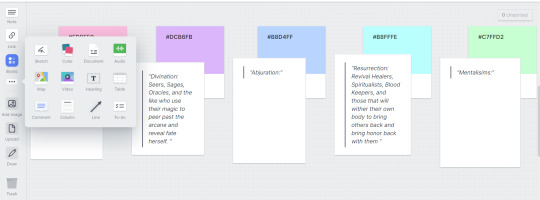
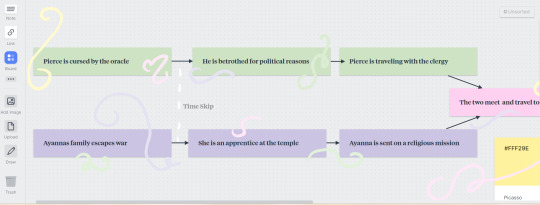
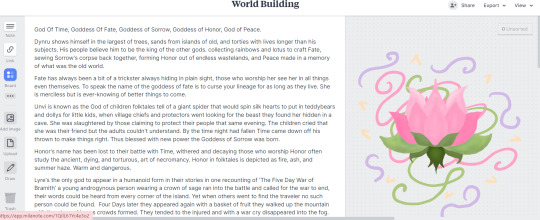
Miro
Miro is a flowchart website mainly used for corporate jobs, however, it can be a great plotting tool for that reason
Miro has a lot of great starter templates if you are looking for a more structured freeform experience. It also comes with a blank page as well.
Unfortunately, I'd argue that it's a bit of a hard tool for beginners to use without a template, I've learned copy-paste is my best friend with Miro the hard way.
It's much better than most platforms at making timelines though.
It has a limit of three boards which is a bit disappointing but overall, I think it's worth the try.
5/10 Miro is very middle of the road for me due to the limited ability to customize things and the free limit. Here are some pics:
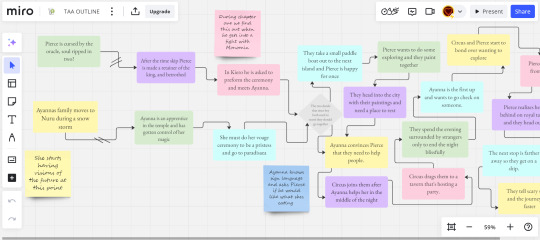
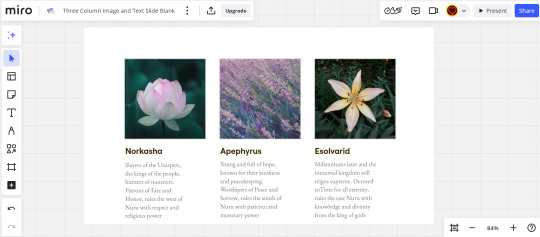
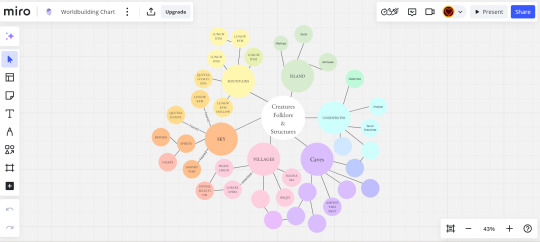
[I wrote that part weeks ago, I am now fully using Miro and believe it's the best for making timelines and charts, I just wish it let me make more boards 8/10]
Hiveword
This might be someone's jam, I can't really say it's mine though.
First off, the unpaid version is really just a few boxes saying "Write a summary here." which makes it just not worth it in my opinion
There really isn't any way to customise things which is my favorite part of most of these softwares
I've barely used this, so maybe there's something I'm missing but
1/10, Just use Google Docs at this point, here's a couple pics
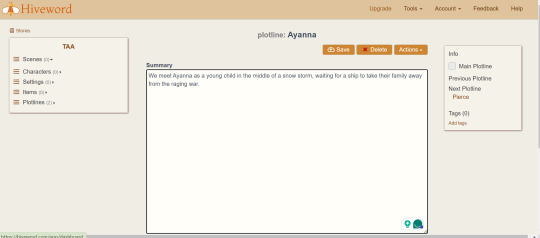

World Anvil
People like this software, it's mainly used for tabletop, which is just a different way of writing adventure, and I've seen it recommended by authors.
Unfortunately, I'm going to disagree with a lot of people and say it's hard to use and isn't even really good at plotting.
I may be biased on this one as every time I've tried to use it in the past I've struggled. However, it seems like another just write it in a document and create a folder.
I'd say it's closer to an organizing tool, but even then just use something else.
3/10, I have nothing to say about it but maybe you'll enjoy it, all here are two photos
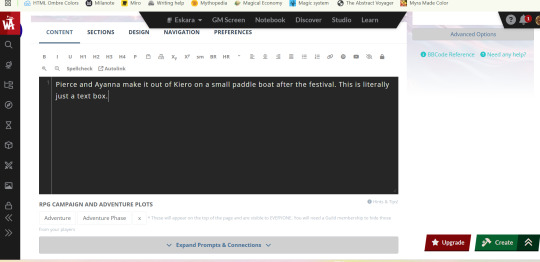

Campfire
This is the one I think I've heard the most about, but have never actually tried.
right off the bat, I'm going to say this is 100% worth it, you'll see at the end with the photos but this is like if Miro and World Anvil had an organization baby.
It's extremely easy to understand, and it makes timelines, it's more for writing your whole book but idk about that yet.
7/10, its themes are really pretty but it limits how much you can do to 20 I believe. Here are the photos
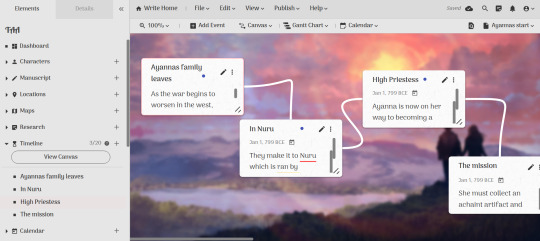
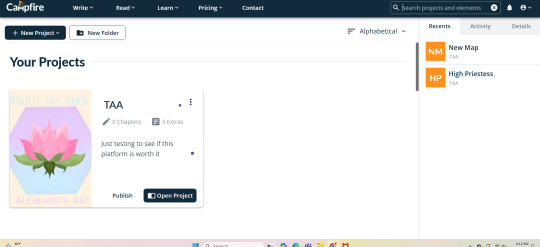
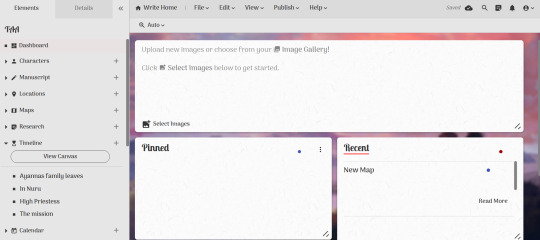
That's all for now, honestly, I think you should use Miro if you are looking to plot things out, and Milanote if you want to collect and organize your thoughts for writing, as that's what I do. Obviously what I like won't be for everyone, but hopefully, this helped you see some options
#writeblr#writers on tumblr#creative writing#worldbuilding#plotting#writing advice#writing tool#writing#writers#writing plans
1K notes
·
View notes
Text
Let's talk about misdirection.
(Requested by @voiceless9000. Hope this is helpful!)
Misdirection in storytelling, through foreshadowing and other techniques, is a powerful tool that can enhance suspense, surprise, and engagement in your narrative and make plot twists more unexpected.
Remember to maintain coherence and avoid contrivances that may undermine the integrity of your storytelling.
Here are some techniques you can use to effectively misdirect readers:
Red herrings: Introduce elements or clues that suggest a certain outcome or plot direction, only to later reveal that they were misleading. These false leads can divert readers' attention away from the true resolution.
Selective detailing: Highlight certain details or events in a way that implies their significance, while downplaying or omitting others that might be more relevant to the actual outcome. By controlling what information readers focus on, you can steer their expectations.
Character misdirection: Use characterisation to mislead readers about characters' true intentions, motivations, or identities. Create multi-dimensional characters who may behave ambiguously or inconsistently, leaving readers unsure of their true allegiances, motivations, or goals.
Foreshadowing: Employ foreshadowing to hint at future events or outcomes, but do so in a way that misleads interpretation. Provide clues that could be interpreted in multiple ways or that lead readers to expect one outcome while delivering another. (See my previous post about foreshadowing for more!)
Misleading narration: Utilise an unreliable narrator or perspective to present events in a biased or distorted manner. Readers may trust the narrator's account implicitly, only to discover later that their perceptions were flawed or intentionally deceptive.
Subverting tropes: Set up situations or scenarios that seem to follow familiar narrative tropes or conventions, only to subvert them in unexpected ways. This can keep readers guessing and prevent them from accurately predicting the story's trajectory.
Parallel storylines: Introduce secondary storylines or subplots that appear unrelated to the main narrative but eventually intersect or influence the primary plot in unexpected ways. This can distract readers from anticipating the main storyline's developments.
Setting: Manipulate the setting or environment to create false impressions about the direction of the plot. For example, presenting a seemingly idyllic setting that harbors dark secrets or dangers.
Timing and pacing: Control the pacing of your story to strategically reveal information or developments at opportune moments, leading readers to draw premature conclusions or overlook important details. (See my post on pacing for more tips!)
Twists and reversals: Incorporate sudden plot twists or reversals that upend readers' expectations and challenge their assumptions about the story's direction. Ensure that these twists are logically consistent but sufficiently surprising to catch readers off guard.
Happy writing!
Previous | Next
#writeblr#writing#writing tips#writing advice#writing help#writing resources#plot development#deception-united
3K notes
·
View notes
Text
20 Alternative Losses Your Protagonist Can Face That Don't Involve the Death of a Person.
In one of my recent posts, I talked about losses as a core principle in driving a plot forward.

It's recommended in almost all guides. But here's the thing: someone doesn't have to actually die to create that emotional rollercoaster.
Here are 20 different losses your protagonist can face without losing someone to the cold hands of death:
1. Loss of a dream job opportunity
2. End of a long-term relationship or marriage
3. Betrayal by a close friend or family member
4. Financial ruin or bankruptcy
5. Loss of a beloved pet (The pet could go missing.)
6. Rejection from a prestigious program or institution
7. Injury or illness leading to the loss of physical abilities
8. Destruction of a childhood home
9. Loss of custody of a child
10. Failure to achieve a lifelong dream or goal
11. Being falsely accused of a crime
12. Natural disaster destroying personal belongings and home
13. Loss of a valuable family heirloom
14. Experiencing discrimination or injustice
15. Being forced to move away from a beloved community
16. Losing a significant competition or contest
17. Loss of memory or cognitive abilities
18. Falling out with a mentor or role model
19. Closure of a cherished local business
20. Loss of one's reputation due to scandal or rumor
Thank you for all of your support. If you love my blog, consider gifting me a rose. Val's here, and I hope your characters are ready to paint the town red.
Check out this printable template that helps you structure the nuanced parts of your plot you normally skip out on.
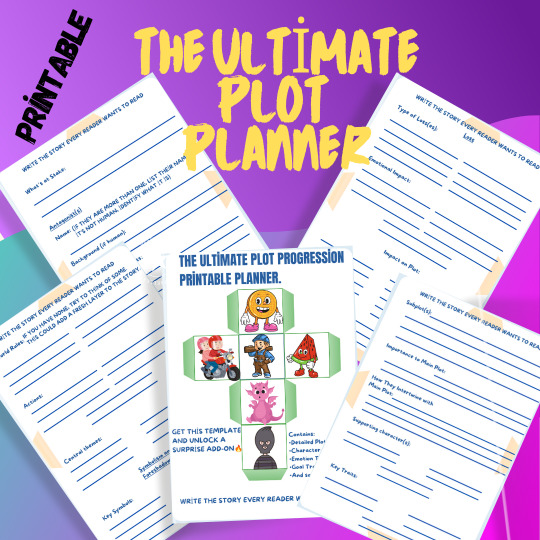
You also receive a free add-on that enhances your plot. It saves you time and helps you maintain quality.
#writeblr#writers on tumblr#writing#writers and poets#writerscommunity#writer#writing community#ao3 writer#wattpad#a03 writer#writers#writing prompts#writing guide#writing advice#writing reference#writing resources#writing habits#writing help#writing blog#writing techniques#writing template#writing tips and tricks#writing tool#writing tips#writing plot#plot problems#aspiring writer#writer and poets#writer blog#writer help
824 notes
·
View notes